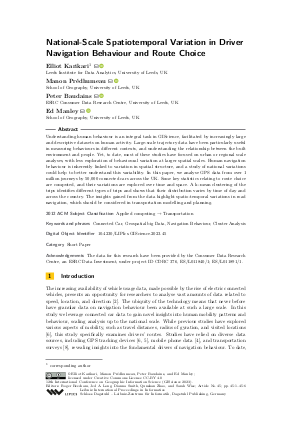National-Scale Spatiotemporal Variation in Driver Navigation Behaviour and Route Choice (Short Paper)
Authors
Elliot Karikari  ,
Manon Prédhumeau
,
Manon Prédhumeau  ,
Peter Baudains
,
Peter Baudains  ,
Ed Manley
,
Ed Manley 
-
Part of:
Volume:
12th International Conference on Geographic Information Science (GIScience 2023)
Part of: Series: Leibniz International Proceedings in Informatics (LIPIcs)
Part of: Conference: International Conference on Geographic Information Science (GIScience) - License:
 Creative Commons Attribution 4.0 International license
Creative Commons Attribution 4.0 International license
- Publication Date: 2023-09-07
File

PDF
LIPIcs.GIScience.2023.45.pdf
- Filesize: 1.52 MB
- 6 pages
Document Identifiers
Subject Classification
ACM Subject Classification
- Applied computing → Transportation
Keywords
- Connected Car
- Geospatial big Data
- Navigation Behaviour
- Cluster Analysis
Metrics
- Access Statistics
-
Total Accesses (updated on a weekly basis)
0Document
0Metadata
Abstract
Understanding human behaviour is an integral task in GIScience, facilitated by increasingly large and descriptive datasets on human activity. Large-scale trajectory data have been particularly useful in measuring behaviours in different contexts, and understanding the relationship between the built environment and people. Yet, to date, most of these studies have focused on urban or regional scale analyses, with less exploration of behavioural variation at larger spatial scales. Human navigation behaviour is inherently linked to variation in spatial structure, and a study of national variations could help to better understand this variability. In this paper, we analyse GPS data from over 1 million journeys by 50,000 connected cars across the UK. Some key statistics relating to route choice are computed, and their variations are explored over time and space. A k-mean clustering of the trips identifies different types of trips and shows that their distribution varies by time of day and across the country. The insights gained from the data highlight spatio-temporal variations in road navigation, which should be considered in transportation modelling and planning.
Cite As Get BibTex
Elliot Karikari, Manon Prédhumeau, Peter Baudains, and Ed Manley. National-Scale Spatiotemporal Variation in Driver Navigation Behaviour and Route Choice (Short Paper). In 12th International Conference on Geographic Information Science (GIScience 2023). Leibniz International Proceedings in Informatics (LIPIcs), Volume 277, pp. 45:1-45:6, Schloss Dagstuhl – Leibniz-Zentrum für Informatik (2023)
https://doi.org/10.4230/LIPIcs.GIScience.2023.45
BibTex
@InProceedings{karikari_et_al:LIPIcs.GIScience.2023.45,
author = {Karikari, Elliot and Pr\'{e}dhumeau, Manon and Baudains, Peter and Manley, Ed},
title = {{National-Scale Spatiotemporal Variation in Driver Navigation Behaviour and Route Choice}},
booktitle = {12th International Conference on Geographic Information Science (GIScience 2023)},
pages = {45:1--45:6},
series = {Leibniz International Proceedings in Informatics (LIPIcs)},
ISBN = {978-3-95977-288-4},
ISSN = {1868-8969},
year = {2023},
volume = {277},
editor = {Beecham, Roger and Long, Jed A. and Smith, Dianna and Zhao, Qunshan and Wise, Sarah},
publisher = {Schloss Dagstuhl -- Leibniz-Zentrum f{\"u}r Informatik},
address = {Dagstuhl, Germany},
URL = {https://drops.dagstuhl.de/entities/document/10.4230/LIPIcs.GIScience.2023.45},
URN = {urn:nbn:de:0030-drops-189404},
doi = {10.4230/LIPIcs.GIScience.2023.45},
annote = {Keywords: Connected Car, Geospatial big Data, Navigation Behaviour, Cluster Analysis}
}
Author Details
Acknowledgements
The data for this research have been provided by the Consumer Data Research Centre, an ESRC Data Investment, under project ID CDRC 376, ES/L011840/1; ES/L011891/1.
References
-
C Bongiorno, Y Zhou, M Kryven, D Theurel, A Rizzo, P Santi, J Tenenbaum, and C Ratti. Vector-based pedestrian navigation in cities. Nat. Comput. Sci, 1(10):678-685, 2021.

-
R Coppola and M Morisio. Connected car: technologies, issues, future trends. ACM Comput. Surv., 49(3):1-36, 2016.

-
E Karikari, M Prédhumeau, P Baudains, and E Manley. Analysing connected car data to understand vehicular route choice. In 31st Annual Geographical Information Science Research UK Conference (GISRUK), Glasgow, Scotland, 2023.

-
L Li, S Wang, and F-Y Wang. An analysis of taxi driver’s route choice behavior using the trace records. IEEE Trans. Comput. Soc. Syst., 5(2):576-582, 2018.

-
EJ Manley, JD Addison, and T Cheng. Shortest path or anchor-based route choice: a large-scale empirical analysis of minicab routing in London. J. Transp. Geogr., 43:123-139, 2015.

-
L Pappalardo, S Rinzivillo, Z Qu, D Pedreschi, and F Giannotti. Understanding the patterns of car travel. Eur. Phys. J. Spec. Top., 215:61-73, 2013.

-
L Pappalardo, F Simini, G Barlacchi, and R Pellungrini. scikit-mobility: A Python library for the analysis, generation and risk assessment of mobility data. J. Stat. Softw., 2022.

-
B Yin and F Leurent. What are the multimodal patterns of individual mobility at the day level in the Paris region? A two-stage data-driven approach based on the 2018 Household Travel Survey. Transportation, pages 1-30, 2022.

